Shaotian Yan
Enhancing Large Language Models with Reward-guided Tree Search for Knowledge Graph Question and Answering
May 18, 2025Abstract:Recently, large language models (LLMs) have demonstrated impressive performance in Knowledge Graph Question Answering (KGQA) tasks, which aim to find answers based on knowledge graphs (KGs) for natural language questions. Existing LLMs-based KGQA methods typically follow the Graph Retrieval-Augmented Generation (GraphRAG) paradigm, which first retrieves reasoning paths from the large KGs, and then generates the answers based on them. However, these methods emphasize the exploration of new optimal reasoning paths in KGs while ignoring the exploitation of historical reasoning paths, which may lead to sub-optimal reasoning paths. Additionally, the complex semantics contained in questions may lead to the retrieval of inaccurate reasoning paths. To address these issues, this paper proposes a novel and training-free framework for KGQA tasks called Reward-guided Tree Search on Graph (RTSoG). RTSoG decomposes an original question into a series of simpler and well-defined sub-questions to handle the complex semantics. Then, a Self-Critic Monte Carlo Tree Search (SC-MCTS) guided by a reward model is introduced to iteratively retrieve weighted reasoning paths as contextual knowledge. Finally, it stacks the weighted reasoning paths according to their weights to generate the final answers. Extensive experiments on four datasets demonstrate the effectiveness of RTSoG. Notably, it achieves 8.7\% and 7.0\% performance improvement over the state-of-the-art method on the GrailQA and the WebQSP respectively.
Don't Take Things Out of Context: Attention Intervention for Enhancing Chain-of-Thought Reasoning in Large Language Models
Mar 14, 2025Abstract:Few-shot Chain-of-Thought (CoT) significantly enhances the reasoning capabilities of large language models (LLMs), functioning as a whole to guide these models in generating reasoning steps toward final answers. However, we observe that isolated segments, words, or tokens within CoT demonstrations can unexpectedly disrupt the generation process of LLMs. The model may overly concentrate on certain local information present in the demonstration, introducing irrelevant noise into the reasoning process and potentially leading to incorrect answers. In this paper, we investigate the underlying mechanism of CoT through dynamically tracing and manipulating the inner workings of LLMs at each output step, which demonstrates that tokens exhibiting specific attention characteristics are more likely to induce the model to take things out of context; these tokens directly attend to the hidden states tied with prediction, without substantial integration of non-local information. Building upon these insights, we propose a Few-shot Attention Intervention method (FAI) that dynamically analyzes the attention patterns of demonstrations to accurately identify these tokens and subsequently make targeted adjustments to the attention weights to effectively suppress their distracting effect on LLMs. Comprehensive experiments across multiple benchmarks demonstrate consistent improvements over baseline methods, with a remarkable 5.91% improvement on the AQuA dataset, further highlighting the effectiveness of FAI.
Seeing Clearly by Layer Two: Enhancing Attention Heads to Alleviate Hallucination in LVLMs
Nov 15, 2024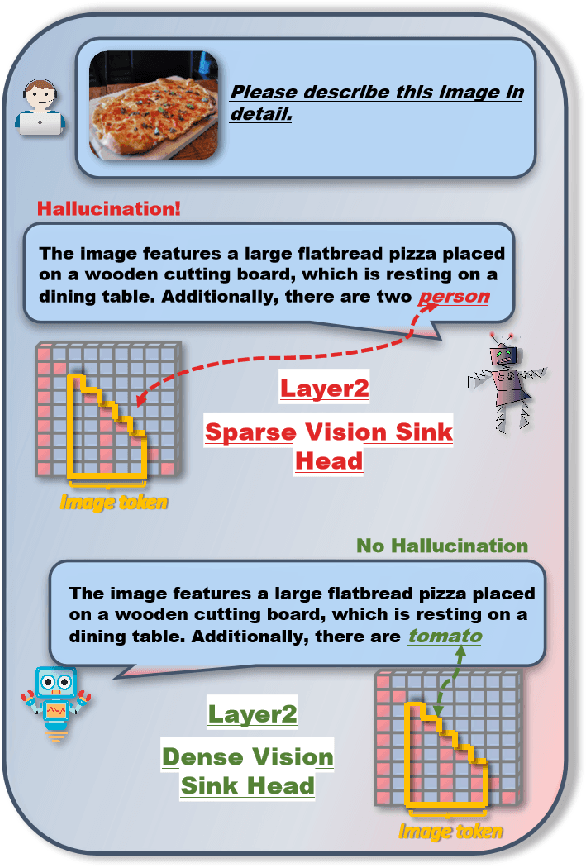
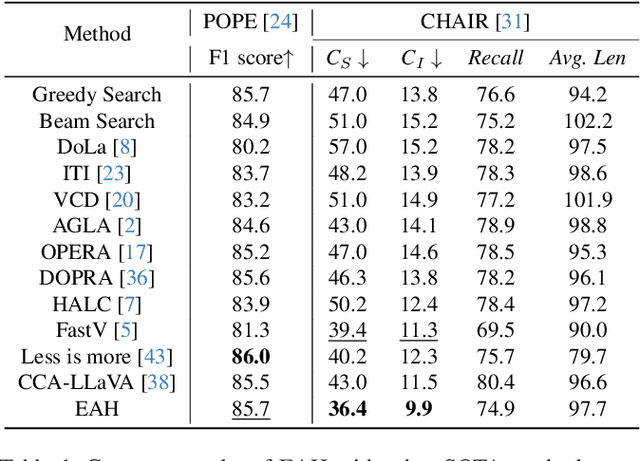
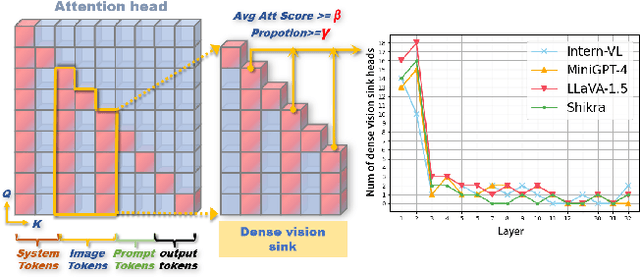
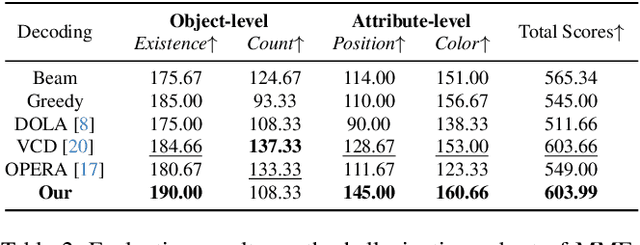
Abstract:The hallucination problem in multimodal large language models (MLLMs) remains a common issue. Although image tokens occupy a majority of the input sequence of MLLMs, there is limited research to explore the relationship between image tokens and hallucinations. In this paper, we analyze the distribution of attention scores for image tokens across each layer and head of the model, revealing an intriguing and common phenomenon: most hallucinations are closely linked to the pattern of attention sinks in the self-attention matrix of image tokens, where shallow layers exhibit dense attention sinks and deeper layers show sparse attention sinks. We further analyze the attention heads of different layers and find that heads with high-density attention sink in the image part play a positive role in alleviating hallucinations. In this paper, we propose a training-free method named \textcolor{red}{\textbf{E}}nhancing \textcolor{red}{\textbf{A}}ttention \textcolor{red}{\textbf{H}}eads (EAH), an approach designed to enhance the convergence of image tokens attention sinks in the shallow layers. EAH identifies the attention head that shows the vision sink in a shallow layer and extracts its attention matrix. This attention map is then broadcast to other heads in the layer, thereby strengthening the layer to pay more attention to the image itself. With extensive experiments, EAH shows significant hallucination-mitigating performance on different MLLMs and metrics, proving its effectiveness and generality.
Instance-adaptive Zero-shot Chain-of-Thought Prompting
Sep 30, 2024



Abstract:Zero-shot Chain-of-Thought (CoT) prompting emerges as a simple and effective strategy for enhancing the performance of large language models (LLMs) in real-world reasoning tasks. Nonetheless, the efficacy of a singular, task-level prompt uniformly applied across the whole of instances is inherently limited since one prompt cannot be a good partner for all, a more appropriate approach should consider the interaction between the prompt and each instance meticulously. This work introduces an instance-adaptive prompting algorithm as an alternative zero-shot CoT reasoning scheme by adaptively differentiating good and bad prompts. Concretely, we first employ analysis on LLMs through the lens of information flow to detect the mechanism under zero-shot CoT reasoning, in which we discover that information flows from question to prompt and question to rationale jointly influence the reasoning results most. We notice that a better zero-shot CoT reasoning needs the prompt to obtain semantic information from the question then the rationale aggregates sufficient information from the question directly and via the prompt indirectly. On the contrary, lacking any of those would probably lead to a bad one. Stem from that, we further propose an instance-adaptive prompting strategy (IAP) for zero-shot CoT reasoning. Experiments conducted with LLaMA-2, LLaMA-3, and Qwen on math, logic, and commonsense reasoning tasks (e.g., GSM8K, MMLU, Causal Judgement) obtain consistent improvement, demonstrating that the instance-adaptive zero-shot CoT prompting performs better than other task-level methods with some curated prompts or sophisticated procedures, showing the significance of our findings in the zero-shot CoT reasoning mechanism.
From Redundancy to Relevance: Enhancing Explainability in Multimodal Large Language Models
Jun 04, 2024



Abstract:Recently, multimodal large language models have exploded with an endless variety, most of the popular Large Vision Language Models (LVLMs) depend on sequential visual representation, where images are converted into hundreds or thousands of tokens before being input into the Large Language Model (LLM) along with language prompts. The black-box design hinders the interpretability of visual-language models, especially regarding more complex reasoning tasks. To explore the interaction process between image and text in complex reasoning tasks, we introduce the information flow method to visualize the interaction mechanism. By analyzing the dynamic flow of the information flow, we find that the information flow appears to converge in the shallow layer. Further investigation revealed a redundancy of the image token in the shallow layer. Consequently, a truncation strategy was introduced to aggregate image tokens within these shallow layers. This approach has been validated through experiments across multiple models, yielding consistent improvements.
Concise and Organized Perception Facilitates Large Language Models for Deductive Reasoning
Oct 05, 2023



Abstract:Exploiting large language models (LLMs) to tackle deductive reasoning has garnered growing attention. It still remains highly challenging to achieve satisfactory results in complex deductive problems, characterized by plenty of premises (i.e., facts or rules) entailing intricate relationships among entities and requiring multi-hop reasoning. One intuitive solution is to decompose the original task into smaller sub-tasks, and then chain the multiple casual reasoning steps together in a forward (e.g., Selection-Inference) or backward (e.g., LAMBADA) direction. However, these techniques inevitably necessitate a large number of overall stages, leading to computationally expensive operations and a higher possibility of making misleading steps. In addition to stage-by-stage decomposition, we draw inspiration from another aspect of human problem-solving. Humans tend to distill the most relevant information and organize their thoughts systematically (e.g., creating mind maps), which assists them in answering questions or drawing conclusions precisely and quickly. In light of this, we propose a novel reasoning approach named Concise and Organized Perception (COP). COP carefully analyzes the given statements to efficiently identify the most pertinent information while eliminating redundancy. It then prompts the LLMs in a more organized form that adapts to the model's inference process. By perceiving concise and organized proofs, the deductive reasoning abilities of LLMs can be better elicited, and the risk of acquiring errors caused by excessive reasoning stages is mitigated. Furthermore, our approach can be combined with the aforementioned ones to further boost their performance. Extensive experimental results on three popular deductive benchmarks (i.e., ProofWriter, PrOntoQA and PrOntoQA-OOD) show that COP significantly outperforms previous state-of-the-art methods.
PCPL: Predicate-Correlation Perception Learning for Unbiased Scene Graph Generation
Sep 02, 2020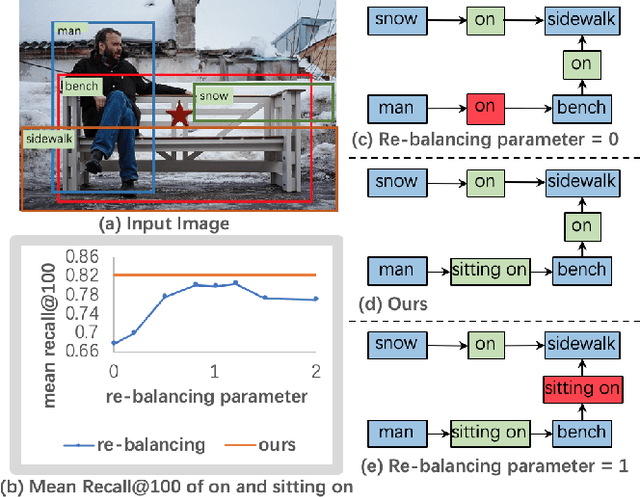
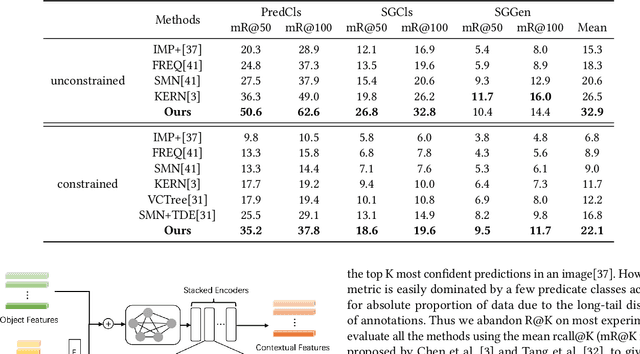
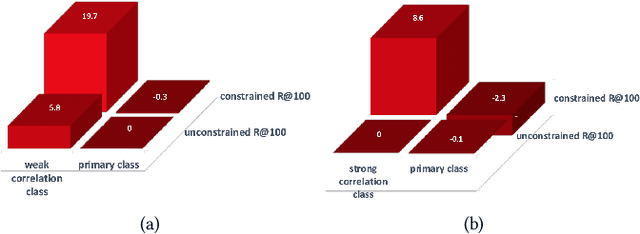

Abstract:Today, scene graph generation(SGG) task is largely limited in realistic scenarios, mainly due to the extremely long-tailed bias of predicate annotation distribution. Thus, tackling the class imbalance trouble of SGG is critical and challenging. In this paper, we first discover that when predicate labels have strong correlation with each other, prevalent re-balancing strategies(e.g., re-sampling and re-weighting) will give rise to either over-fitting the tail data(e.g., bench sitting on sidewalk rather than on), or still suffering the adverse effect from the original uneven distribution(e.g., aggregating varied parked on/standing on/sitting on into on). We argue the principal reason is that re-balancing strategies are sensitive to the frequencies of predicates yet blind to their relatedness, which may play a more important role to promote the learning of predicate features. Therefore, we propose a novel Predicate-Correlation Perception Learning(PCPL for short) scheme to adaptively seek out appropriate loss weights by directly perceiving and utilizing the correlation among predicate classes. Moreover, our PCPL framework is further equipped with a graph encoder module to better extract context features. Extensive experiments on the benchmark VG150 dataset show that the proposed PCPL performs markedly better on tail classes while well-preserving the performance on head ones, which significantly outperforms previous state-of-the-art methods.
 Add to Chrome
Add to Chrome Add to Firefox
Add to Firefox Add to Edge
Add to Edge